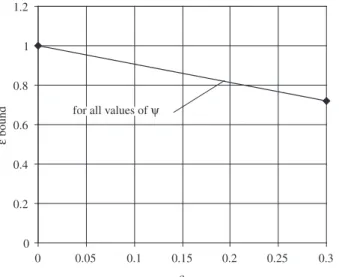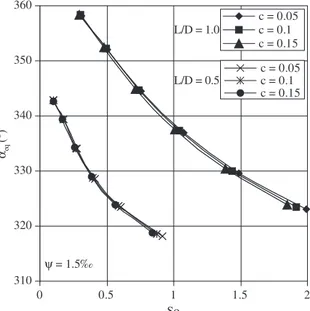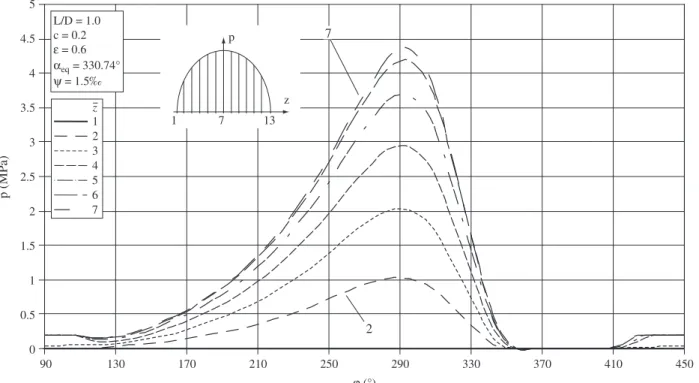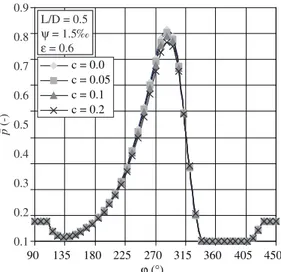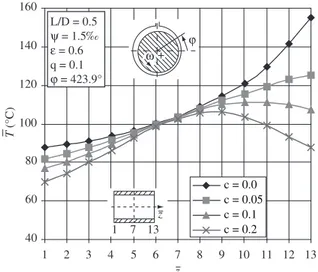*e-mail: strzelec@pkm1.p.lodz.pl
Operating Characteristics of Heavy Loaded Cylindrical
Journal Bearing with Variable Axial Profile
Stanislaw Strzelecki*
Lodz University of Technology, Department of Mechanical Engineering,
90-924 LODZ, Poland
, Stefanowskiego 1/15
Received: July 19, 2004; Revised: July 25, 2005
During the operation of turbounit its bearings displace as a result of heat elongation of bearings supports. It changes the static delection line of rotor determined during assembly of the turbounit, causing an increase in the stresses on the bearing edges and a decrease in the dynamic state of the machine. One of possibilities to avoid the edge stresses is to apply the bearings with variable axial proile, e.g. hyperboloidal, convex proile in the axial cross-section of bearing. Application of journal bearings with hyperboloidal proile allows to extend the bearing operation range without the stress concentration on the edges of bush. These bearings successfully carry the extreme load in conditions of misaligned axis of journal and the bush eliminating the necessity of using self-aligning bearings. Operating characteristics of bearing include the resulting force, attitude angle, oil ilm pressure and temperature distributions, minimum oil ilm thickness, maximum oil ilm temperature. In literature there is a lack of data on the operating characteristics of heavy loaded hyperboloidal journal bearings operating at the conditions of adiabatic oil ilm and static equilibrium position of the journal. For the hyperboloidal bearing the operating characteristics have been obtained. Different values of length to diameter ratio, assumed shape and inclination ratio coeficients have been assumed. Iterative solution of the Reynolds', energy and viscosity equations was applied. Adiabatic oil ilm, laminar low in the bearing gap as well as aligned and misaligned orientation of journal in the bush were considered.
Keywords:lubrication, journal bearings
1. Introduction
The fulilment of condition for journal and bush axis parallelism as well as co-axiality of bushes bores, is problematic in the practice. An increase in precise positioning of these elements causes a signii-cant increase in costs of machining.
The rotor which is generally supported between two bearings (Fig-ure 1a) causes bending of shaft in relation to the bearing. Misaligned shaft affects the bearings characteristics and signiicantly diminishes the range of safe bearing operation. It generates the mixed friction and transient conditions of unstable operation. Misalignment of journal bearing can be caused by position errors, too (Figure 1b).
Journal bearings with hyperboloidal proile extend the bearing operation range without the stress concentration on the edges of bush. The load can be carried without application of self-aligning bearings, Burcan1.
High speed bearings are slightly loaded opposite to the low speed heavy loaded ones. Romacker2 deines slightly loaded bearings as the bearings running at relative eccentricities of journal smaller than 20%, at Sommerfeld numbers about 0.1 for the bearings with the length to diameter ratio 0.5. Operating characteristics of these bearings can be determined by means of one dimensional energy equation. Heavy loaded bearings have to be calculated by means of the two or three dimensional energy equation. Calculation procedure should deliver the temperature in each point within oil ilm. As-sumption of mean temperature on the oil ilm thickness accelerates the calculation.
In literature, there is a lack of data on the operating characteristics of heavy loaded misaligned hyperboloidal journal bearings running with laminar, adiabatic oil ilm and at the static equilibrium position of the journal.
For the hyperboloidal bearing the operating characteristics as oil ilm pressure, temperature ields, static equilibrium position
angle, Sommerfeld number, maximum oil ilm temperature have been obtained by iterative solution of the Reynolds’, energy and viscosity equations. Adiabatic oil ilm, laminar low in the bearing gap as well as aligned and misaligned orientation of journal in the bush, were considered. Static equilibrium position of the journal3-5 was assumed too.
2. Geometry of Lubricating Gap
The proile variation of hyperboloidal bearing which is given by Equation 1 gives in reality a negligible modiication of cylindrical bush; it allows to use the Reynolds Equation 2 for describing the oil low in the bearing gap, Burcan1. The case of misaligned axis of journal and bush of hyperboloidal proile is showed in Figure 2. The oil ilm thickness is given by the following equation:
(1)
Since the hyperboloidal bearing has larger side oil leakages and the loss of load capacity is larger than for the cylindrical one, the bear-ing proile coeficient c should not exceed 0.3 (Figure 3). Boundary values of relative eccentricity are in Figure 4.
3. Oil Film Pressure and Temperature Distribution
Pressure distribution has been deined from Equation 2 on the assumption of variable viscosity
(2)
(z = + L/2) the oil ilm pressure p(j, z) = 0, and in the regions of negative pressures, p(j,z) = 0.
Oil ilm pressure distribution computed from Equation 2 has been put in the transformed energy Equation 3.
(3)
The viscosity is described by exponential equation3,5. Temperature and viscosity distribution has been found by the iterative solution of Equations 1, 2 and 33. The bound-ary condition for the temperature takes into account the tem-perature of inlet oil. Temtem-perature values T(j, z) on the boundaries (z = + L / 2 ) have been determined by means of the parabolic ap-proximation3.
4. Results of Calculation
Numerical calculations were performed for two different values of aspect ratio i.e. L/D = 0.5 and 1.0, clearance ratio y = 1.5‰, hyperboloidal proile coeficient c = 0.0, 0.05, 0.1, 0.2 and relative inclination ratio q = 0.0 and 0.1.
These sets of parameters allow to determine the effect of: • Bush geometry i.e. bearing length to diameter ratio L/D and
shape coeficient c;
• Journal position i.e. relative inclination ratio q and relative eccentricity on the operating characteristics which include the oil ilm: pressure p, temperature T distributions, Sommerfeld number So, static equilibrium position angle αeq, oil ilm thick-ness H and maximum temperature Tmax;
• Some results of calculations have been presented for the relative eccentricity ε = 0.6 corresponding to the conditions of heavy loaded bearing.
Results of theoretical calculation have been presented in Figure 5 through Figure 18. Computed oil ilm thickness H in the axial cross-section of bearing and for different values of hyperboloid proile coef-icient c, can be seen in Figure 5. Sommerfeld numbers So obtained at different hyperboloid proile coeficients c and relative inclination
Ob
Z
g
Ob
Oj
Z.tan
Figure 2. Geometry of hyperboloidal bearing.
Figure 1. a) Bending of the shaft; and b) position errors at stiff shaft. (a)
f
(b)
Figure 3. Relative inclination ratio q vs. the bearing relative eccentricity ε for different values of hyperboloidal proile coeficient c, Burcan1.
c = 0.3
c = 0.2
c = 0.1 1.3
1.1
1.0
0.7
0.5
0.3
0.1
0 0.2 0.4 0.6 0.8
c = 0 c = 0.05
q
Figure 4. Boundary values of relative eccentricity (in the middle plain of bush) over hyperboloidal proile coeficient c Burcan1.
0 0.2 0.4 0.6 0.8 1 1.2
0 0.05 0.1 0.15 0.2 0.25 0.3
c
bound
Figure 7. Static equilibrium position angle for different bearing length to diameter ratio and hyperboloid shape coeficient.
Figure 6. Effect of hyperboloid coeficient c and relative inclination ratio q on the Sommerfeld number.
Figure 8. Maximum oil ilm temperature for different hyperboloid proile coeficient.
coeficient q are shown in Figure 6; at assumed hyperboloid proile coeficient c an increase in relative inclination coeficient q causes the increase in Sommerfeld number and the values are smaller in case of hyperboloid bearing (c ≠0). Than in case of cylindrical one (c = 0). Static equilibrium position angles αeq obtained for two values of bear-ing length to diameter ratio L/D and assumed values of hyperboloid proile coeficient, are given in Figure 7; there is a small decrease in static equilibrium position angles αeq with an increase in hyperboloid proile coeficient c. Maximum oil ilm temperature Tmax computed at different hyperboloid proile coeficients c are shown in Figure 8; an increase in proile coeficient c causes the increase in maximum oil ilm temperature.
Oil ilm pressure and temperature distributions for the bearing with the length to diameter ratio L/D = 1.0 relative eccentricity
ε = 0.6 and hyperboloid proile coeficient c = 0.2 are shown in Figure 9 and Figure 10, these distributions are for axial coordinate ranging from z = 1 and z = 7. An effect of hyperboloidal proile coeficient c on the oil ilm pressure and temperature distributions in the peripheral and axial directions can be observed in Figure 11 through Figure 18. In the range of assumed values, the hyperboloid proile coeficient c has little effect on both distributions (Figure 11 and Figure 12); oil ilm pressure distribution shows the decrease in the neighbourhood of peak pressures (Figure 11). Comparison of the oil ilm pressure and temperature distributions for two values of
Figure 5. Oil ilm thickness in the axial cross section at the chosen angular coordinate and for different hyperboloid coeficients.
1 2 3 4 5 6 7 8 9 10 11 12 13
z L/D = 0.5
= 372. 6°
= 0.6 =1.5‰ q = 0.1
H
(-)
+ 0.8
0.75
0.7
0.65
0.6
0.55
0.5
c = 0.0 c = 0.05 c = 0.1 c = 0.2
0.2 0.3 0.4 0.5 0.6
L/D = 0.5
=1.5‰
So
c = 0 q = 0 c = 0 q = 0.1 c = 0.2 q = 0 c = 0.2 q = 0.1 1.4
1.2
1
0.8
0.6
0.4
0.2
0
310 320 330 340 350 360
0 0.5 1 1.5 2
eq
(°)
So
= 1.5‰
L/D = 1.0
L/D = 0.5
c = 0.05 c = 0.1 c = 0.15
c = 0.05 c = 0.1 c = 0.15
0.1 0.3 0.5 0.7 0.9 1.1 1.3 1.5
So L/D =1.0
= 1.5‰
c = 0.05 c = 0.1 c = 0.2 80
75
70
65
60
55
50 Tmax
Figure 9. Oil ilm pressure distributions in different peripheral cross-sections of bearing.
bearing length to diameter ratio L/D at assumed hyperboloid proile coeficient c, shows larger changes of oil ilm pressures (Figure 13) than the temperatures (Figure 14).
The oil ilm pressure and temperature distributions calculated in axial cross-sections of bearing at different peripheral coordinates
j and different hyperboloidal proile coeficients c are shown in Figure 15 and Figure 16; there is a decrease in the values of pressure
(Figure 15) and in the side temperatures (Figure 16) at the increase in the values of hyperboloid proile coeficient c.
An effect of relative inclination ratio q on the oil ilm temperature distribution in the axial cross-sections, at different values of hyperbo-loid proile coeficient c and at assumed peripheral coordinate j, can be observed in Figure 17 and Figure 18. An increase in hyperboloid proile coeficient c causes the strong decrease in the values of tem-perature on the sides of bearing.
Figure 10. Oil ilm temperature distributions in different peripheral cross-sections of bearing.
90 130 170 210 250 290 330 370 410 450
2
p (MP
a)
p
z
1 7 13
L/D = 1.0 c = 0.2
= 0.6
eq= 330.74°
= 1.5‰ 5
4.5
4
3.5
3
2.5
2
1.5
1
0.5
0
7
1 2 3 4 5 6 7 z
(°)
90 141.8 193.1 244.4 295.6 346.9 398.2 450
T (°C)
(°)
7
1
T
Z
1 7 13
80
75
70
65
60
55
50
45
40
L/D = 1.0 c = 0.2
= 0.6
eq= 330.74°
= 1.5‰
Figure. 11 Oil ilm pressure distribution for different values of hyperboloid proile coeficient.
Figure 14. Oil ilm pressure and temperature distributions at assumed rela-tive eccentricity.
90 135 180 225 270 315 360 405 450
L/D = 0.5
= 1.5‰
= 0.6
0.9
0.8
0.7
0.6
0.5
0.4
0.3
0.2
0.1
c = 0.0 c = 0.05 c = 0.1 c = 0.2
p
(-)
T
(-)
90 142 193 244 296 347 398 450
L/D = 1.0
= 1.5‰
= 0.6 p (-) T (-) 1.8
1.6
1.4
1.2
1
0.8
0.6
0.4
0.2
0
25
20
15
10
5
0
(°)
p
(-)
Figure 12. Oil ilm temperature distribution for different values of hyperboloid proile coeficient.
90 135 180 225 270 315 360 405 450
L/D = 0.5
= 1.5‰
= 0.6
c = 0.0 c = 0.05 c = 0.1 c = 0.2
25
20
15
10
5
0
T
(-)
Figure 15. Oil ilm pressure distributions at assumed relative eccentricity.
1 2 3 4 5 6 7 8 9 10 11 12 13
z +
+
L/D = 0.5
= 1.5‰
= 0.6
= 287.1°
c = 0.0 c = 0.05 c = 0.1 c = 0.2
1
0.8
0.6
0.4
0.2
0
p
(-)
Figure 13. Oil ilm pressure and temperature distributions at assumed rela-tive eccentricity.
90 142 193 244 296 347 398 450
L/D = 0.5
c = 0.2
= 1.5‰
= 0.6 1.8
1.6
1.4
1.2
1
0.8
0.6
0.4
0.2
0
25
20
15
10
5
0
p
(-)
p (-)
T (-)
T
(-)
Figure 16. Oil ilm temperature distributions at assumed relative eccentric-ity.
1 2 3 4 5 6 7 8 9 10 11 12 13
z +
L/D = 0.5
= 1.5‰
= 0.6
= 423.9°
c = 0.0 c = 0.05 c = 0.1 c = 0.2
80
75
70
65
60
T
5. Conclusions
The results of calculation of operating characteristics of aligned and misaligned, hyperboloidal journal bearing have been presented. They allow the following conclusions:
1. Developed program of computation allows theoretical in-vestigation of aligned and misaligned journal bearings with hiperboloid proile of the bush;
2. The oil ilm pressure and temperature distributions in the axial direction are inluenced by the hyperboloid proile coeficient and relative inclination one;
3. The maximum oil ilm temperature shows small increase with the increase in the hyperboloidal proile coeficient at assumed load capacity and assumed length to diameter ratio.
References
1. Burcan J. Hyperboloidal journal bearing. 1973. Problems of Machine Exploitation; 1973. p. 321-333.
2. Romacker B. Die Temperaturverteilung im Schmierfilm konstant be-lasteter Gleitlager. Technische Untersuchungen und Entwicklung eines Messverfahrens. [D.Phil.thesis]. Karlsruhe. University of Technology Karlsruhe; 1965.
3. Strzelecki S. Operating conditions of hyperboloidal journal bearing with nonisothermal oil ilm. In: Stachowiak G, editor. AUSTRIB’94, Frontiers in Tribology Proceedings of the 4th International Tribology
Conference. 1994 Dec 5-8; Perth, Australia. Perth: Perth University. 1994. p. 579-585.
4. Strzelecki S, Litwicki W. Static characteristics of 2-lobe hyperboloidal journal bearing. In: Burcan J, editor. Non-Conventional Bearings Systems. Proceedings of the 3rd Conference on the Problems of Non-Conventional
Bearings Systems. 1997 Aug 12-16, Lodz, Poland. Lodz. Lodz University of Technology. 1997. p. 125-132.
5. Strzelecki S, Litwicki W. Dynamic characteristics of hyperboloidal 2-lobe journal bearing. In: Institute of Fluid Flow Machinery, editor. Modelling and Design in Fluid-Flow Machinery. Proceedings of the IMP’97 Confer-ence. 1997 June 12-16, Gdansk, Poland. Gdansk, Institute of Fluid Flow Machinery. 1997. p. 339-344.
Nomenclature
c hyperboloidal proile coeficients D bush diameter (m)
Fstat static load of the bearing (N)
g value of hyperboloidal bush modiication in relation to cylindrical one measured on the bush face (m)
h oil ilm thickness (m)
H dimensionless oil ilm thickness H = h/(R-r) L bearing length (m)
p oil ilm pressure (MPa)
p dimensionless pressure, p = p⋅y2/(η⋅ω) Pe Peclet's number r cωr2 / h
q inclination ratio, q = (L/s). tan k r journal diameter (m)
R bush diameter (m)
So Sommerfeld number, So = Fstat⋅y2 / (L⋅D⋅η⋅ω)
T dimensionless temperature, T = T/T0 T Temperature, (°C)
T0 supplied oil temperature (°C)
t time (s)
z dimensionless axial coordinate, z = 2z/L
α attitude angle (°)
η dimensionless viscosity, η=η/η0
η dynamic viscosity (Ns/m2)
ηo dynamic viscosity at ambient temperature (Ns/m 2)
αeq attitude angle in static equilibrium position of the journal (°)
j circumferential coordinate (°)
φ dimensionless time, φ=ωt
k inclination angle in the middle plane of bearing (longitudinal cross section)
ε relative eccentricity, ε = e / (R - r)
y relative bearing clearance, y= s/D (‰)
ω angular velocity, s-1 ‰ per mil (‰ = 10-3) Figure 17. Oil ilm temperature distribution at assumed relative eccentricity.
40 60 80 100 120 140 160
1 2 3 4 5 6 7 8 9 10 11 12 13
z +
L/D = 1.0
= 1.5‰
= 0.6 q = 0.1
= 423.9°
c = 0.0 c = 0.05 c = 0.1 c = 0.2
T
(°C)
Figure 18. Oil ilm temperature distributions at assumed relative eccentricity.
40 60 80 100 120 140 160
+ L/D = 0.5
= 1.5‰
= 0.6 q = 0.1
= 423.9°
c = 0.0 c = 0.05 c = 0.1 c = 0.2
T
(°C)
z
1 7 13
1 2 3 4 5 6 7 8 9 10 11 12 13
